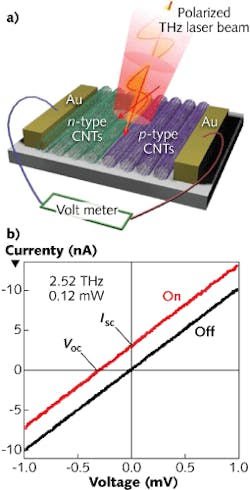Terahertz Detectors: Large-area carbon-nanotube terahertz detector is broadband and polarization-sensitive
With applications in astronomy, sensing, defense and security, and communications, terahertz detectors are in high demand. To date, terahertz detectors made from antenna-coupled, bundled, and individual metallic single-walled carbon nanotubes (CNTs) or even graphene-based devices exhibit very small collection areas and typically require coupling of the terahertz radiation with antennas.
Recognizing that narrowband, cryogenic, small-area terahertz detectors serve only limited terahertz-detection applications, researchers at Rice University (Houston, TX), Tokyo Institute of Technology (Tokyo Tech; Japan), and Sandia National Laboratories (Livermore, CA) have successfully collaborated in the development of a large-area, broadband, polarization-dependent, and room-temperature-operable terahertz detector that uses an ensemble of single-wall CNTs with mixed chirality.1
Broadband operation
Single-wall CNTs with mixed chirality can absorb radiation at essentially any wavelength in the electromagnetic spectrum via intraband (free-carrier) and interband (excitonic) absorption, a property shared with graphene.
The solid-state CNT-based terahertz detector begins with aligned ultralong CNTs grown vertically on a silicon substrate through chemical vapor deposition. They are then transferred to a Teflon substrate to form a highly flexible film of horizontally aligned CNTs. This film is strongly polarization-dependent due to the aligned nature of the nanotubes and collective antenna effects. The n-type region is made by doping the as-grown p-type CNT film with benzyl viologen; two gold electrodes complete the p-n junction detector device (see figure).
When illuminated with terahertz light at 3.11, 2.52, and 1.39 THz, responsivity values are 2.5, 2.4, and 1.7 V/W, respectively. The noise-equivalent-power, a figure of merit for photodetectors, is 20 nW/Hz1/2 at room temperature—a value already approaching that of existing uncooled terahertz detectors. Through a series of experiments the research team demonstrated the photothermoelectric nature of the response, which clears the path towards improving the noise-equivalent-power by correspondingly improving the device design and the thermoelectric properties of the CNT thin film.
“This work opens up a new avenue for developing terahertz detectors that are low cost and flexible,” says François Léonard, distinguished member of technical staff at Sandia. “We are looking for partners to further develop the technology and realize its full promise.”
REFERENCE
1. Xiaowei He et al., Nano Letters 14, 7, 3953–3958 (May 29, 2014).

Gail Overton | Senior Editor (2004-2020)
Gail has more than 30 years of engineering, marketing, product management, and editorial experience in the photonics and optical communications industry. Before joining the staff at Laser Focus World in 2004, she held many product management and product marketing roles in the fiber-optics industry, most notably at Hughes (El Segundo, CA), GTE Labs (Waltham, MA), Corning (Corning, NY), Photon Kinetics (Beaverton, OR), and Newport Corporation (Irvine, CA). During her marketing career, Gail published articles in WDM Solutions and Sensors magazine and traveled internationally to conduct product and sales training. Gail received her BS degree in physics, with an emphasis in optics, from San Diego State University in San Diego, CA in May 1986.
